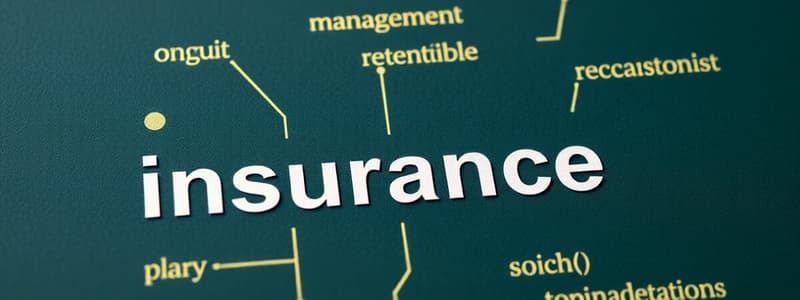Podcast
Questions and Answers
What is the definition of a peril in the context of risk?
What is the definition of a peril in the context of risk?
- A general form of loss that may occur over time
- An immediate, specific event that causes loss (correct)
- A reduction in the severity of a loss
- A condition that increases the likelihood of loss
Which statement accurately describes pure risk?
Which statement accurately describes pure risk?
- It represents the total risk coverage provided by an insurer
- It includes opportunities for gain along with loss
- It encompasses speculative ventures with uncertain outcomes
- It involves only the chance of loss and is insurable (correct)
What is risk transfer?
What is risk transfer?
- The responsibility for a loss is shifted to another party for a cost (correct)
- The act of assuming risks for potential gains
- The exchange of accountability for a risk for a higher premium
- The sharing of risks among individuals to reduce exposure
What best describes risk management?
What best describes risk management?
In the context of insurance, what does the term 'self-insurance' refer to?
In the context of insurance, what does the term 'self-insurance' refer to?
Which of the following best describes 'risk avoidance'?
Which of the following best describes 'risk avoidance'?
What is the role of a reinsurer?
What is the role of a reinsurer?
What does 'risk sharing' involve?
What does 'risk sharing' involve?
What is meant by 'risk selection' in insurance?
What is meant by 'risk selection' in insurance?
What does risk reduction focus on in risk management?
What does risk reduction focus on in risk management?
What is the primary consequence of adverse selection in insurance?
What is the primary consequence of adverse selection in insurance?
Which of the following best describes 'moral hazard'?
Which of the following best describes 'moral hazard'?
What does an indemnity contract aim to achieve?
What does an indemnity contract aim to achieve?
What does 'loss exposure' refer to in the context of insurance?
What does 'loss exposure' refer to in the context of insurance?
How does the Law of Large Numbers affect insurance predictions?
How does the Law of Large Numbers affect insurance predictions?
Which of the following is NOT a characteristic of homogeneous exposure units?
Which of the following is NOT a characteristic of homogeneous exposure units?
What is considered a 'peril' in insurance terminology?
What is considered a 'peril' in insurance terminology?
What is the difference between moral hazard and morale hazard?
What is the difference between moral hazard and morale hazard?
Flashcards
Peril
Peril
An event causing loss and giving rise to risk.
Physical Hazard
Physical Hazard
A tangible condition that increases the likelihood of a loss.
Primary Insurance Company
Primary Insurance Company
The first insurer responsible for a claim when multiple policies cover it.
Pure Risk
Pure Risk
Signup and view all the flashcards
Reinsurance
Reinsurance
Signup and view all the flashcards
Reinsurer
Reinsurer
Signup and view all the flashcards
Risk Avoidance
Risk Avoidance
Signup and view all the flashcards
Risk Management
Risk Management
Signup and view all the flashcards
Risk Transfer
Risk Transfer
Signup and view all the flashcards
Speculative Risk
Speculative Risk
Signup and view all the flashcards
Adverse Selection
Adverse Selection
Signup and view all the flashcards
Hazard
Hazard
Signup and view all the flashcards
Homogeneous Exposure Units
Homogeneous Exposure Units
Signup and view all the flashcards
Indemnify
Indemnify
Signup and view all the flashcards
Indemnity
Indemnity
Signup and view all the flashcards
Law of Large Numbers
Law of Large Numbers
Signup and view all the flashcards
Loss Exposure
Loss Exposure
Signup and view all the flashcards
Moral Hazard
Moral Hazard
Signup and view all the flashcards
Study Notes
Adverse Selection
- Adverse selection is when higher-risk individuals are more likely to seek or maintain insurance than lower-risk individuals.
- It occurs when the proportion of bad risks among insured policies exceeds actuarial predictions.
- Policyholders also tend to exploit favorable insurance policy options.
Hazard
- A hazard is any factor increasing the possibility of a peril occurring.
- It could be a situation, condition, or factor.
Homogeneous Exposure Units
- These are similar objects (people, businesses, or property) exposed to the same perils.
- Each unit represents a similar risk.
Indemnify
- To indemnify is to restore someone to their financial position before a loss.
Indemnity
- Indemnity is the amount needed to restore someone financially to their pre-loss state.
- It can be reimbursement or a fixed amount.
Indemnity Contract
- An indemnity contract aims to return the insured to their pre-loss financial condition.
Law of Large Numbers
- This insurance principle states that combining many individual risks leads to more accurate prediction of overall losses.
Loss
- Loss, in insurance, is the unintentional decrease in asset value due to a peril.
Loss Exposure
- Loss exposure is the risk of potential loss.
Loss Exposure Unit
- A loss exposure unit is an individual, organization, or asset exposed to potential loss from a specific peril.
- Aggregating units reveals overall loss exposure.
Moral Hazard
- Moral hazard arises from an insured's reputation, character, habits, or financial responsibility, including criminal activity.
Morale Hazard
- Morale hazard occurs when insurance encourages carelessness and indifference towards loss.
Peril
- A peril is the immediate event (cause) of a loss.
Physical Hazard
- A physical hazard is a tangible condition that increases the likelihood of a loss.
Primary Insurance Company
- In multiple policies covering one claim, the primary insurer pays first.
- In reinsurance, the primary insurer underwrites the risk and transfers a part to reinsurers.
Pure Risk
- Pure risk involves only the chance of loss, no gain.
- It's the only insurable risk.
Reinsurance
- Reinsurance is when one or more insurers (reinsurers) take a portion of another insurer's risk.
- The primary insurer transfers part of the risk to the reinsurer.
Reinsurer
- A reinsurer is an insurer that takes a portion of another insurer's risk.
Risk
- Risk is the uncertainty of loss, the chance of loss for someone.
Risk Avoidance
- Risk avoidance is entirely evading a risk, not engaging in something risky.
Risk Management
- Risk management analyzes risk exposures and develops plans to address them.
Risk Reduction
- Risk reduction decreases the chance of loss or minimizes the severity.
Risk Retention
- Risk retention is accepting potential loss.
- This is often associated with self-insurance.
Risk Selection
- Risk selection is how insurance companies decide on insuring a new risk.
- The ratio of losses to premium should match actuarial predictions.
Risk Sharing (Risk Pooling or Loss Sharing)
- Risk sharing is pooling risk and loss costs among many individuals.
- This transfers risk from the individual to a group.
Risk Transfer
- Risk transfer involves shifting the loss responsibility to another party.
- The cost is a preset premium.
Self-Insurance
- Self-insurance is a risk retention strategy.
- Money is set aside to cover potential losses.
Speculative Risk
- Speculative risk involves the chance of both loss and gain.
- It's not insurable.
Studying That Suits You
Use AI to generate personalized quizzes and flashcards to suit your learning preferences.




